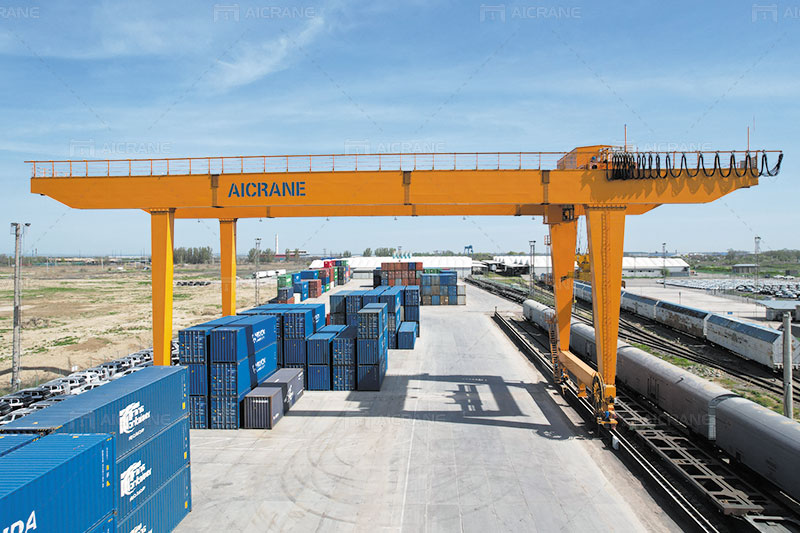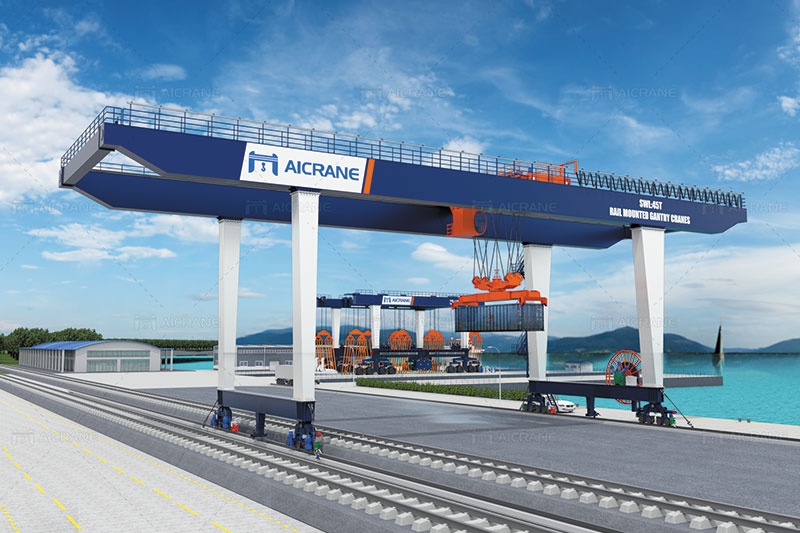Rail Mounted Gantry (RMG) cranes have become a cornerstone of modern container yard operations. With their ability to lift, move, and stack containers efficiently and with high precision, RMG cranes have transformed container terminals worldwide. Their unique design and operational capabilities have allowed ports and shipping terminals to handle increasing container volumes and enhance the overall flow of cargo. This article delves into the impact of RMG cranes on container yard operations, exploring their key advantages, operational efficiency, safety benefits, and the role they play in the growth of global trade.

What are Rail Mounted Gantry Cranes?
Rail Mounted Gantry Cranes are specialized cranes designed to travel along a fixed rail track system. These cranes are primarily used for loading and unloading containers at container terminals, especially in yards where large volumes of containers need to be handled. Unlike rubber-tyred gantry cranes, which are mobile, RMGs are fixed to a rail track, providing a stable and efficient method of moving containers between storage locations, ships, and trucks. The rail mounted gantry crane typically consists of a large gantry frame with hoisting mechanisms capable of lifting containers from the ground to the height of the container stacks.
Key Advantages of Rail Mounted Gantry Cranes in Container Yard Operations
1. Increased Efficiency and Productivity
One of the primary benefits of RMG cranes is their ability to increase operational efficiency in container yards. These cranes are designed to move containers quickly and precisely, significantly reducing the time required for container handling. Their ability to operate in high-density storage environments, where containers are stacked in rows, allows for rapid retrieval and delivery of containers to and from vessels or trucks. This efficiency leads to faster turnarounds of vessels, better port throughput, and the ability to handle larger volumes of cargo.
The gantry cranes also help optimize yard space utilization, as they can operate in narrow aisles between stacked containers. The height at which they can lift containers allows for higher stacking, maximizing the use of vertical space in busy terminals. This, in turn, minimizes the need for additional land or storage facilities, reducing costs and increasing throughput.

2. High Capacity and Heavy Load Handling
RMG cranes are specifically designed to handle large volumes of heavy containers, with lifting capacities often exceeding 40 tons per unit. Their robust construction allows them to safely transport heavy containerized goods, which is essential in modern container yards where the demand for moving large, heavy containers is continuously increasing. This makes them an ideal solution for ports handling large container ships and heavy cargo.
By having the capacity to lift multiple containers in a single operation, RMG container handling gantry crane eliminates the need for excessive handling equipment, thus improving operational efficiency. Moreover, the ability to carry heavier loads also reduces the number of cranes needed to handle specific tasks, streamlining overall container yard operations.
3. Precision and Accuracy in Container Handling
Precision in container handling is critical to ensure that containers are stored and retrieved with minimal risk of damage. RMG cranes are equipped with advanced positioning systems that enable highly accurate container placement, ensuring that containers are placed in the correct storage location or delivered to the correct truck or ship. This level of precision reduces operational errors, minimizes the chances of mishandling or misplacement of containers, and ensures that container stacking is efficient and organized.
This enhanced accuracy is not only important for improving efficiency but also for optimizing container yard layouts, reducing congestion, and ensuring smoother container movements. This accuracy is essential in managing large-scale container operations, where the number of movements is significant and the margin for error is minimal.
4. Safety Enhancements
Safety is always a top priority in any industrial setting, and container yards are no exception. Rail Mounted Gantry Cranes have built-in safety features that enhance the safety of both operators and the equipment. Their fixed rails reduce the risk of accidents caused by crane movements on unstable ground, which can be an issue for mobile cranes.
The design of the RMG crane also reduces the potential for collisions or misplacement of containers, thanks to advanced control systems and sensors that guide crane movement. Additionally, RMG cranes are often equipped with overload protection mechanisms and emergency stop systems to prevent accidents during operation. This ensures that cranes stop in case of any malfunction, preventing potential damage to both the overhead gantry crane and the containers.
Furthermore, operator safety is enhanced through remote control systems, which allow crane operators to control movements from a distance, keeping them out of harm’s way during crane operation. This remote operation also reduces operator fatigue and increases the comfort and focus of the personnel.
5. Cost-Effectiveness and Return on Investment (ROI)
While the initial investment in Rail Mounted Gantry Cranes can be significant, the long-term benefits far outweigh the upfront costs. The increased operational efficiency, faster turnaround times, and higher container throughput all contribute to a higher return on investment. Container terminals can serve more vessels and handle larger cargo volumes, leading to greater revenue generation.
Moreover, RMG cranes are designed to have long operational lifespans, often exceeding 20 years of service with proper maintenance. This durability further adds to their cost-effectiveness. By reducing the need for frequent equipment replacements and minimizing downtime, RMG cranes prove to be a wise investment for container yard operations.
The Role of RMG Cranes in Global Trade Growth
Rail Mounted Gantry Cranes are a key enabler of the growth of global trade, as they are pivotal in keeping pace with the increasing demand for faster, more efficient shipping services. With the rise of larger container ships and the growing need to manage ever-expanding container volumes, ports and terminals are under pressure to enhance their handling capabilities. RMG cranes allow them to do so, ensuring that they can continue to provide timely, efficient, and cost-effective services.
The growth of mega container vessels, which can carry up to 20,000 containers or more, has put immense pressure on container terminals to expand their capacity and enhance their operational efficiency. RMG cranes are vital in this context, as they enable terminals to handle larger volumes of containers in a streamlined manner, while also maximizing the use of available space.
Furthermore, the intermodal gantry cranes are also integral to achieving just-in-time delivery systems in global supply chains. They allow for faster loading and unloading of cargo, ensuring that containers are processed and delivered to their destinations on time. This contributes to minimizing delays in the transportation of goods, leading to a more reliable global trade network.
Challenges and Future Trends
While RMG cranes offer numerous benefits, there are also challenges associated with their use. These include the high capital costs of acquisition and installation, as well as ongoing maintenance requirements to ensure optimal performance over time. Additionally, the rail system needs to be well-maintained, as any issues with the tracks can result in delays and safety concerns.
Looking ahead, there are several trends in RMG crane technology that promise to further enhance container yard operations. For instance, the integration of automation and artificial intelligence (AI) in crane operations will further increase the efficiency of container handling, allowing cranes to perform tasks without direct human intervention. Innovations in crane design, such as the introduction of hybrid and fully electric models, will also contribute to sustainability by reducing fuel consumption and emissions.
Conclusion
Rail Mounted Gantry Cranes have had a profound impact on container yard operations by improving efficiency, safety, and capacity. Their precision, cost-effectiveness, and ability to handle heavy loads have made them an indispensable tool in the modern logistics and shipping industry. As global trade continues to grow and container volumes increase, RMG cranes will remain a key enabler of port and terminal productivity. With ongoing technological advancements, these cranes are poised to become even more efficient, further boosting the capabilities of container yard operations and contributing to the continued growth of international trade.